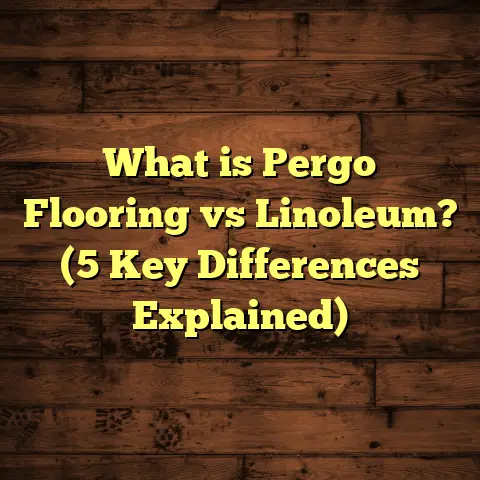What is Better: Ceramic or Porcelain Floor Tile? (5 Key Differences)
Innovation has transformed home design in ways I never imagined when I first started in flooring. Back then, the choices were pretty basic—mostly wood, stone, or simple tile. But as technology advanced, so did the options for floors that are more durable, beautiful, and easier to maintain. Among these modern choices, ceramic and porcelain floor tiles stand out as two of the most popular. But many people ask me, “Which one should I pick? Is porcelain really better than ceramic?” I’ve been working with both materials for years, and today I want to share everything I’ve learned about their differences so you can make the right choice for your home.
What is Ceramic and Porcelain Tile?
Before we dive into the differences, let’s clear up what ceramic and porcelain tiles actually are. At first glance, they look similar; both are types of tiles made from clay and natural materials. But the devil is in the details.
Ceramic tile is made from red or white clay mixed with other natural materials. This mixture is shaped and then fired at relatively lower temperatures (usually between 1,600°F to 2,000°F). After firing, a glaze is applied to the surface to provide color and protect it from water absorption. The glaze also adds shine or matte finish depending on your preference.
Porcelain tile is actually a subtype of ceramic tile but differs significantly in composition and manufacturing. Porcelain uses finer clay and other refined materials like kaolin. It is fired at higher temperatures (about 2,200°F), which makes it much denser and less porous. Due to this density, porcelain tiles absorb less water—typically less than 0.5% compared to ceramic’s 3-7%. This makes porcelain tougher, harder, and more resistant to water and stains.
To put it simply: all porcelain tiles are ceramic, but not all ceramic tiles are porcelain.
When I first started installing tiles over a decade ago, I didn’t realize how important these distinctions were. Many clients just wanted something “nice” and affordable without knowing how different tiles would behave in their homes over time. Over multiple projects—some with challenging environments like humid bathrooms or outdoor patios—I saw firsthand how the right tile choice could save homeowners from headaches down the road.
5 Key Differences Between Ceramic and Porcelain Tile
Now that we know what they are, let’s break down the five main differences that influence your decision: durability, water absorption, appearance, installation complexity, and cost.
1. Durability and Strength
Durability is often the first thing people ask about because no one wants a floor that chips or cracks easily. When it comes to strength, porcelain takes the lead.
Because porcelain is fired at higher temperatures using dense clay, its surface becomes much harder and more resistant to wear. In fact, porcelain tiles generally have a Mohs hardness rating between 7 and 8. This rating measures scratch resistance on a scale from 1 (talc) to 10 (diamond). Compared to ceramic tiles rated around 5 or 6, porcelain stands up better against heavy foot traffic, dropped objects, and even pet claws.
I remember a job where a client wanted durable flooring for their kitchen—a high-traffic area with kids running around constantly. I suggested porcelain because of its toughness. A year later, they told me their floor still looks brand new despite all the activity and occasional dropped utensils.
Ceramic tiles are durable too but better suited for moderate-traffic areas like bathrooms or bedrooms. They can chip more easily if heavy items fall on them or if installed in places with rough wear.
Porcelain’s strength also means it’s a common choice in commercial spaces like restaurants or shopping centers where floors endure heavy foot traffic every day.
Data point: According to the Tile Council of North America (TCNA), porcelain tiles typically have a breaking strength of over 250 pounds per square inch (psi), while ceramic tiles range around 150-200 psi.
2. Water Absorption and Moisture Resistance
Water absorption plays a huge role in where you can install these tiles safely without risking damage.
Porcelain tiles absorb less than 0.5% water due to their dense structure. This makes them virtually impervious to moisture-related problems like staining, warping, or mold growth. For wet areas such as bathrooms, kitchens, laundry rooms, or even outdoor patios exposed to rain or snow, porcelain is usually my go-to recommendation.
I once installed porcelain in a spa bathroom with steam showers and wet floors. After two years with constant moisture exposure, the tiles showed zero signs of water damage—a big relief for my client.
Ceramic tiles have a higher absorption rate (3-7%), making them more susceptible to water penetration unless properly glazed and sealed. Though glazed ceramic can do well in bathrooms or kitchens if maintained correctly, it’s less suited for outdoor or freeze-thaw environments where water absorption can lead to cracking.
Outdoor use: Porcelain’s low water absorption prevents damage during freeze-thaw cycles in colder climates. Ceramic tile installed outside can crack if water seeps in and freezes.
Maintenance tip: If you choose ceramic for wet areas, make sure the grout lines are sealed regularly to prevent moisture from seeping underneath.
3. Appearance and Design Options
When homeowners come to me wanting new floors, aesthetics is often as important as durability. Both ceramic and porcelain come in countless colors, patterns, shapes, and finishes.
Porcelain tiles often have an edge here because manufacturers use advanced digital printing technologies that allow them to mimic natural stone like marble or granite with incredible realism. You can also find porcelain that looks like wood grain or concrete textures—offering high-end looks without high-end prices.
Ceramic tiles tend to have thicker glaze layers that provide vibrant color options but sometimes appear less natural than porcelain’s subtle textures.
From my experience working on kitchens and living rooms where design matters, porcelain offers more consistent color tone and size precision across batches. This uniformity makes installation cleaner and visually pleasing.
However, ceramic’s versatility shouldn’t be underestimated—it comes in traditional patterns like Mexican Talavera or rustic terracotta styles that add character in ways porcelain may not replicate easily.
4. Installation Complexity
If you’re thinking about doing a flooring project yourself or hiring someone new, installation difficulty matters.
Porcelain’s density makes it heavier and harder to cut than ceramic tiles. You need diamond-tipped blades specifically designed for porcelain cutting tools to avoid chipping or cracking during installation.
I’ve seen DIYers get frustrated trying to cut porcelain without proper tools—ending up with wasted tiles and extra costs.
Ceramic tiles are lighter and easier to cut with standard tile cutters or wet saws. This makes them more accessible for small DIY projects or beginners learning tile installation.
Pro tip: If you want porcelain but don’t have experience installing it, hire a professional with specialized equipment and skills. Proper installation affects not just appearance but also long-term performance.
5. Cost Differences
Price can be a dealbreaker for many homeowners deciding between ceramic and porcelain floor tiles.
Porcelain generally costs more upfront—materials often run $5 to $10 per square foot depending on style and finish. Ceramic is usually cheaper at about $1 to $5 per square foot.
Don’t forget labor costs: installations involving porcelain take longer due to cutting challenges and heavier weight, so labor charges tend to be higher as well.
On one project renovating a large family room with porcelain tile flooring, my client was concerned about budget but decided it was worth paying extra for longevity and style.
To avoid surprises in total project cost—materials plus labor—I rely on FloorTally for accurate local estimates. It consolidates material prices, labor rates, waste factors, and even delivery fees into one easy tool that helps me plan budgets realistically before ordering anything.
FloorTally has saved me significant headaches by catching hidden costs early on instead of after installation begins when changes become expensive.
My Experience Using These Tiles on Different Projects
Over the years, I’ve worked on all sorts of flooring projects featuring both ceramic and porcelain tiles—from cozy bathrooms to sprawling commercial spaces.
Bathroom Remodel: A client wanted an affordable yet stylish bathroom upgrade. We chose glazed ceramic tile with a beautiful blue pattern that brightened the space without breaking the bank. After three years with regular cleaning, the tiles still look fresh but show minor wear along edges due to moderate traffic.
Commercial Lobby: For a busy office building lobby, we installed large-format polished porcelain tiles that mimic marble but cost much less. The floors handle daily foot traffic smoothly; cleaning requires just damp mopping with pH-neutral cleaners.
Outdoor Patio: A homeowner wanted an elegant patio that could withstand rain and freezing winters. Porcelain tile was the clear choice because of its low water absorption rating. After two winters exposed to snow and ice, the floor remains intact with no cracks or discoloration.
These experiences taught me how crucial it is to match tile type with environment and use case rather than defaulting to what looks good alone.
Detailed Data Points & Industry Insights
- Water Absorption Rate: Porcelain <0.5%, Ceramic 3-7% (per Tile Council of North America)
- Mohs Hardness: Porcelain 7-8+, Ceramic approx 5-6
- Breaking Strength: Porcelain over 250 psi; Ceramic around 150-200 psi
- Typical Cost per Sq Ft: Porcelain $5-$10; Ceramic $1-$5
- Average Lifespan: Porcelain 25+ years; Ceramic 15-20 years depending on care
- Maintenance Needs: Porcelain requires minimal sealing; Ceramic benefits from grout sealing every few years
Some Questions You Might Have
Can I install porcelain tile over radiant heating?
Yes! Porcelain’s density makes it an excellent conductor of heat for radiant floor systems. It helps distribute warmth evenly without cracking under temperature changes.
Is glazed ceramic waterproof?
Glazed ceramic offers some water resistance but isn’t fully waterproof like porcelain. Sealing grout lines helps protect against moisture damage.
Which tile is better for pets?
Porcelain’s scratch resistance makes it ideal if you have cats or dogs prone to scratching floors. Ceramic can chip more easily under claws.
How does grout affect tile performance?
Good grout quality prevents water seepage beneath tiles which can cause loosening or mold growth over time regardless of tile type used.
Useful Tips Based on My Experience
- Always order extra tiles (usually 10-15% more) to account for cuts and breakage during installation.
- Use spacers during installation for even grout lines.
- Choose grout colors that complement your tile but also hide dirt in high traffic areas.
- Avoid acidic cleaners on both ceramic and porcelain as they can dull glaze.
- When using porcelain outdoors in cold climates, verify it has frost-resistant certification.
- Test sample tiles under your lighting conditions at home before purchasing large quantities.
- Ask your installer about warranty coverage for both materials—some brands offer longer guarantees on porcelain products.
- Don’t skimp on underlayment materials; proper subfloor prep ensures better tile adhesion and longevity.
- If you’re unsure about installation skill level required, consult professionals before starting DIY projects especially with porcelain.
- When budgeting your project costs beyond just materials consider removal of old flooring if applicable—it can add significant labor costs.
How FloorTally Helps Me Plan Flooring Projects
Managing budgets across multiple flooring projects used to be time-consuming and stressful until I started using FloorTally regularly.
It helps me by:
- Providing accurate material cost estimates based on real-time local prices
- Factoring labor rates so I get a realistic total cost upfront
- Including waste percentages so I order enough tile without excess
- Comparing different tile types side-by-side for budget impact
- Saving hours on manual calculations when juggling several projects simultaneously
For instance, last year I had two clients wanting either ceramic or porcelain kitchen floors within similar budgets. FloorTally helped me create quick cost breakdowns showing how switching from ceramic to porcelain would affect total price including installation fees—allowing clients to make informed decisions confidently.
Real-Life Case Study: Family Kitchen Flooring Upgrade
A growing family contacted me needing new kitchen flooring that could cope with spills, kids running around barefooted all day long, pets dropping food scraps constantly—the works!
They wanted something stylish yet durable enough not to wear out after just a couple years. After showing samples of both glazed ceramic tiles (which were colorful) versus polished porcelain stone look-alikes (which looked elegant), they went with porcelain despite higher upfront costs.
Installation took longer because of cuts needed around cabinets and appliances but was flawless thanks to an experienced crew familiar with porcelain handling techniques.
Six months later I checked back: the floor looked pristine even after multiple accidental drops of heavy pots and muddy paw prints tracked in from outside. The clients were thrilled with how easy it was to clean too—just a quick mop every day kept everything sparkling.
This project reinforced my belief in choosing materials not only based on looks but how they perform under real-life conditions expected by homeowners.
Final Thoughts on Choosing Between Ceramic and Porcelain Tile
Both ceramic and porcelain have their place depending on your specific needs:
| Factor | Ceramic | Porcelain |
|---|---|---|
| Durability | Moderate; best for low/moderate traffic | High; ideal for heavy traffic & commercial use |
| Water Absorption | Higher (3-7%) | Very low (<0.5%) |
| Appearance | Wide color range; vibrant glazes | More natural stone/wood mimics; uniform |
| Installation | Easier; lighter & simpler cutting | Harder; requires special tools & skill |
| Cost | More affordable | Higher upfront & labor costs |
If you want longevity combined with moisture resistance and don’t mind investing more upfront, porcelain is likely worth it. If budget constraints exist or you want an easier DIY project in moderate-use areas, ceramic is still an excellent option offering beauty at lower cost.
Take time planning your project carefully—use tools like FloorTally for budgeting—and think about how each tile will handle day-to-day living in your home environment. Flooring isn’t just about looks—it’s about function over many years ahead!
Have you thought about what kind of space you want tiled? Whether it’s a bathroom refresh or complete kitchen overhaul, feel free to ask me questions anytime—I’m happy to share insights from my years on the job!
If you want me to add more sections like maintenance routines or troubleshooting tips next, just let me know!





